Initial Design Ideas
Having a recent obsession with playing GamePigeon’s 8-Ball for iMessage, I knew almost right away that I wanted to theme my pinball game around the actual game of 8-ball as a whole. I have a lot of fun competing with people over the digital version on iMessage, and I also very much enjoy playing it in real life whenever I have the opportunity to. I thought that combining 8-ball and pinball would make for a very unique kind of game.

While initially planning the game, I was going to name it “Pinbilliards“. I did this because I thought that combining the names of the two games would make for a fun title. In order to create a playfield that resembled a pool table, I planned to incorporate a couple of different features, such as:
- Bumpers that represent different billiards
- Holes that represent the pockets in a pool table
- Flippers that resemble pool cues
Trying to think of a way to mix the two games together was a bit of a challenge, but I figured out a way that I think put a different kind of spin on both of the games. The original ruleset for Pin-8-Ball revolved around the player’s ball having its own identity. The identity of the ball would change throughout the game, and the identities that it could have all resembled existing billiards from the actual game of 8-ball. Along with the ball of the player, each bumper also had an identity resembling that of an existing billiard. There would be one bumper for each billiard that has a number. During play, the player’s ball would start as the cue ball after launch and then change its identity to whatever the identity of its most previously hit bumper was. This would happen continuously until the ball went out of play. The player would also receive an assignment: solids or stripes. This assignment was determined by the very first solid or striped bumper that was hit by the player, and it would remain with them for the rest of the game. In order to score, the player would have to get the ball into one of the six holes on the playfield, which would then affect the game depending on what the ball’s identity was when it went out of play. The effects were as follows:
- Matches player’s assigned type: Score points and launch again
- Matches type not assigned to player: Subtract points from score and launch again
- Cue ball: End game
- 8 ball: Double current score and end game
At this point in designing the game, I notably forgot to determine what would happen if the ball fell to the bottom of the board, past the flippers.
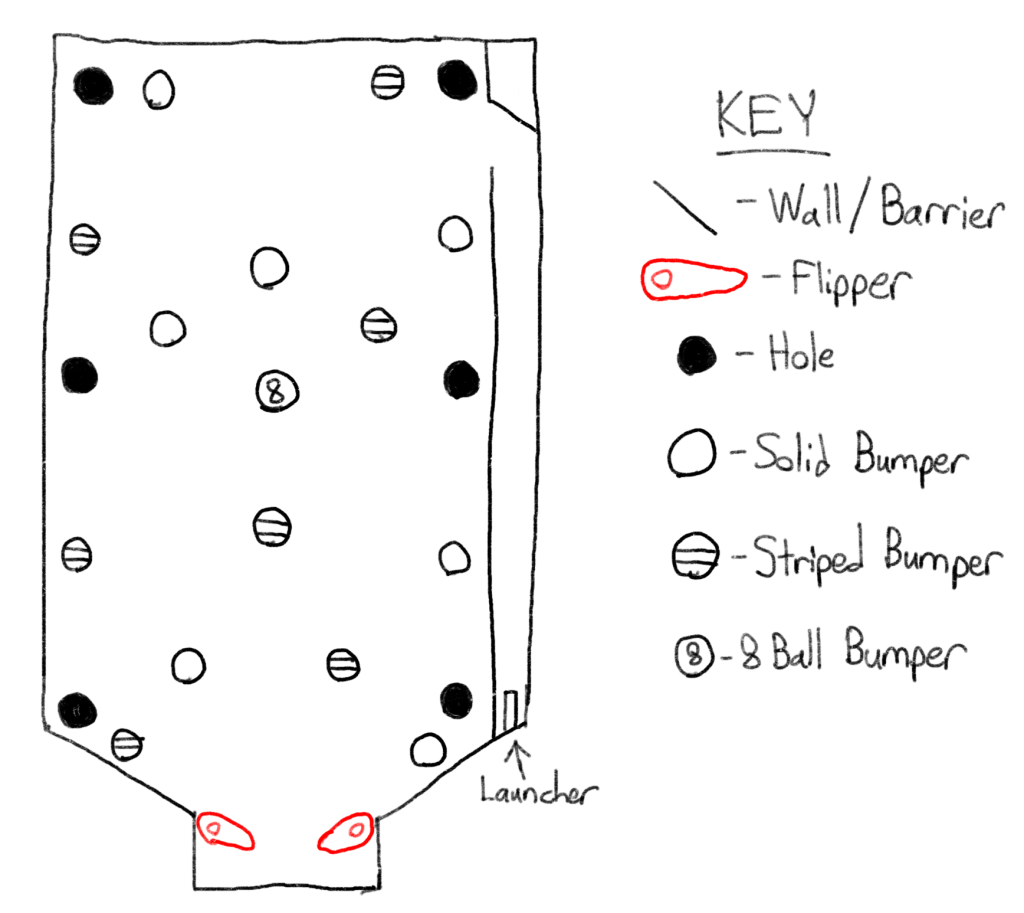
Initial Design
After some planning and beginning to physically build Pin-8-Ball, there were some elements of my original plan that I realized I was going to have to change.
Firstly, in order to make the playfield really look like a pool table, I decided that I’d have to decrease its size and build 3-dimensional walls to place inside of it. This also meant that the ball would have to be spit out of the walls somewhere on the board. I was a little bit worried about making the choice to make the playfield smaller, but I decided to commit to it with hopes that it’d make the eventual final game much more immersive.
After making the playfield smaller, I also realized that I’d have to decrease the amount of bumpers on the playfield. It was already too crowded to begin with, so I decided to decrease the amount of bumpers that would be on the playfield from 15 to 7. This left the game having 3 solid bumpers, 3 striped bumpers, and 1 8 ball bumper. I chose to use billiards number 1, 4, and 7 for the solid bumpers and 9, 12, and 15 for the striped bumpers. I decided upon these ones because they were at even intervals from each other, but they did not have any real significance in accordance with Pin-8-Ball.
Finally, I decided to try and clarify the rules a bit while writing them down on paper. In doing this, I added actual score values, determined what would happen if the ball fell to the bottom of the board, and started referring to the ball’s “identity” as its “type”. It was at this point that I also changed the name of the game from “Pinbilliards” to “Pin-8-Ball“. I decided to change the name because I thought that it both sounded better and would make game’s the theme more obvious.
The prototype’s rule card reads as follows:
- Your ball changes as you play!
- It starts as the cue ball
- It transforms on contact with a bumper into whatever kind of ball it is labelled with
- You will have a ball type – stripes or solids
- This is determined by the first bumper you hit that isn’t the 8 ball
- Solids: 1, 4, 7; Stripes: 9, 12, 15
- Score is determined by what type your ball is when it goes into a hole
At the bottom of the rule card, I made a small table that listed what happened depending on the player’s ball’s type when it went into a hole:
| Matches your type: +100, shoot again |
| Does not match your type: -50, shoot again |
| 8 ball: Double your score, end game |
| Cue ball: End game |
| Ball falls to bottom of board: -50, shoot again |
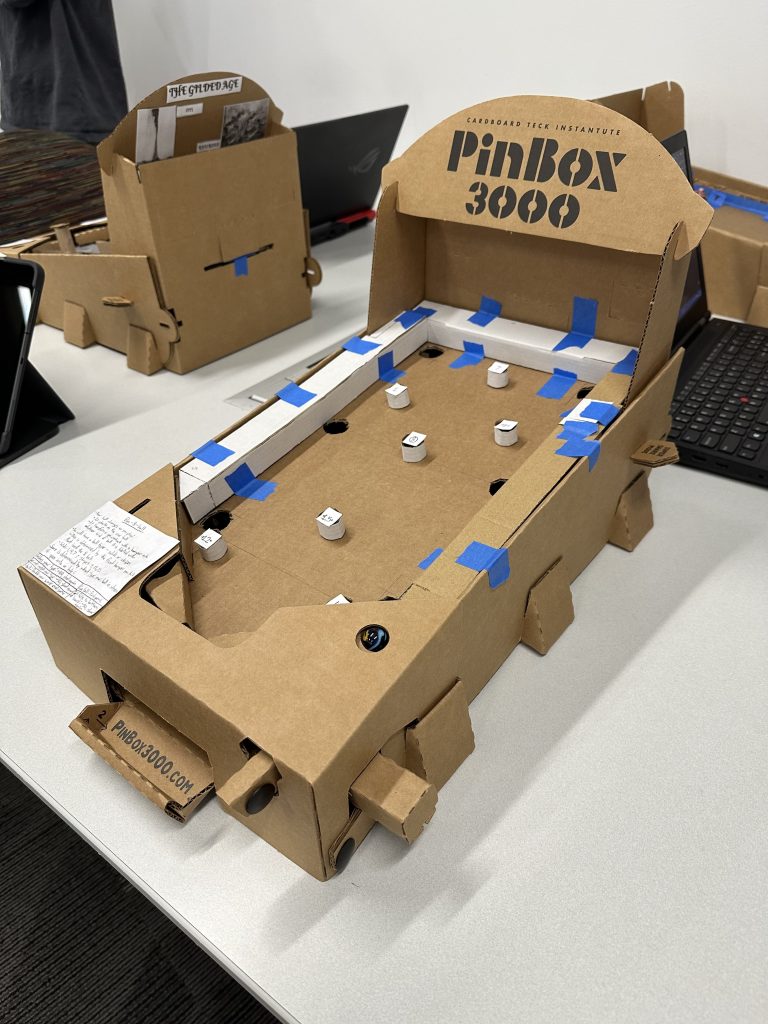
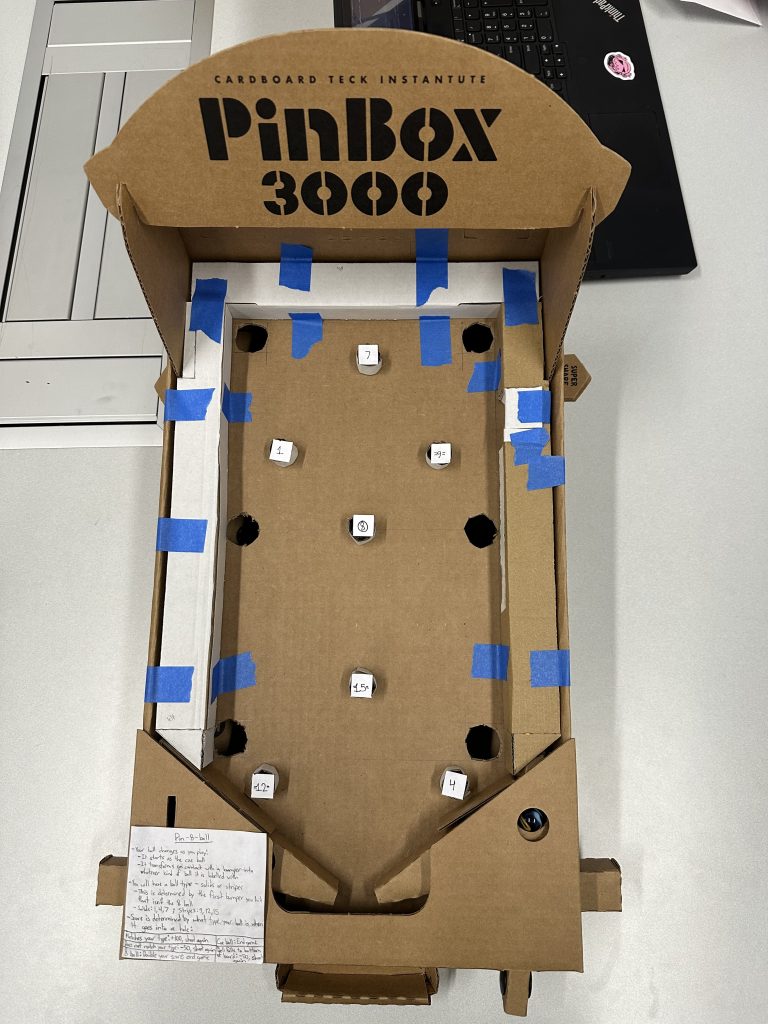
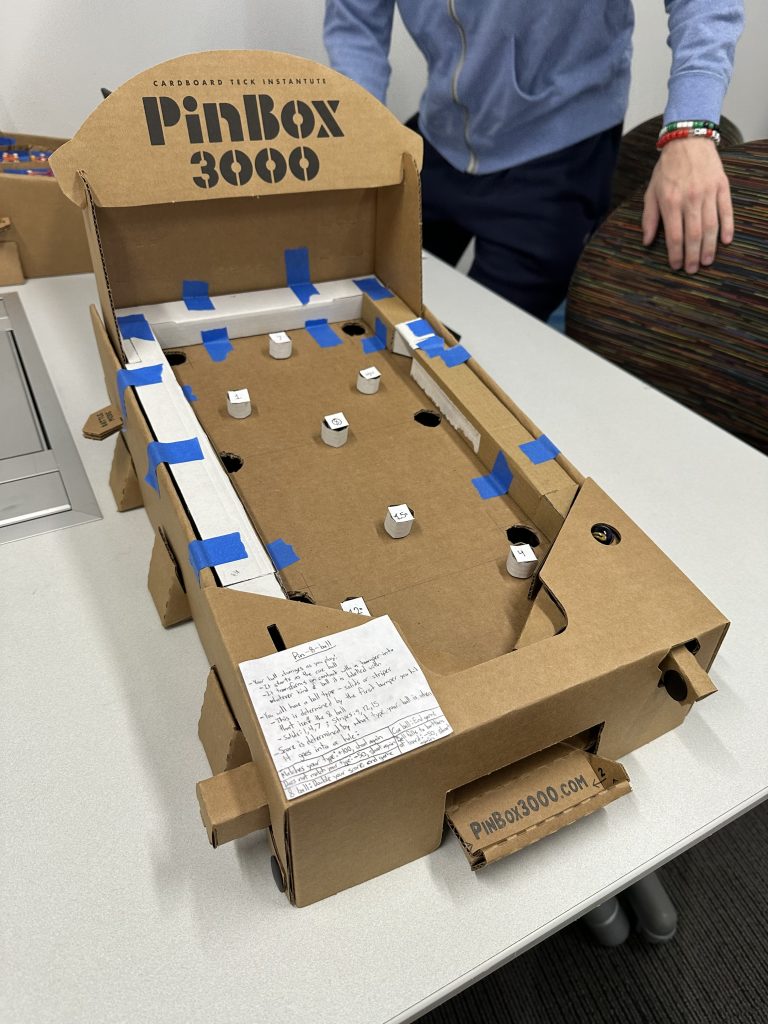
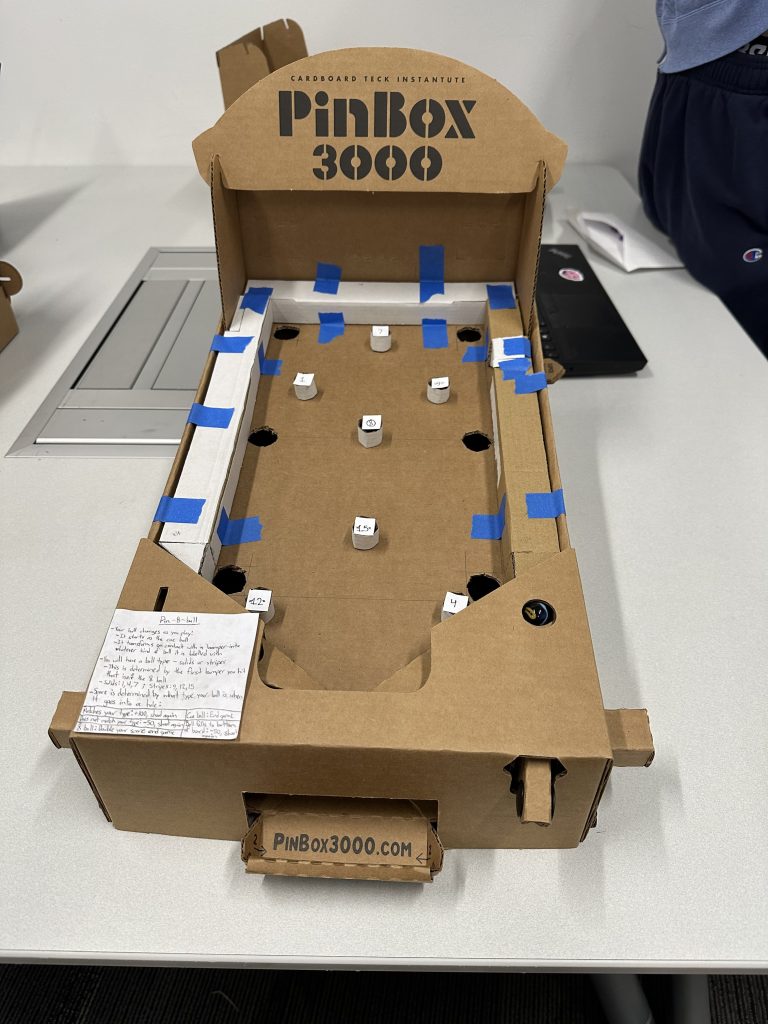
Playtest Results
After playtesting, the I learned that Pin-8-Ball needed some work to be done. Although there was positive reception regarding the theming of the game, the playertesters struggled both with actually playing the game and with understanding the rules.
A lot of the playtesters reported that their ball would go into the holes on the playboard way too easily, making it so that they didn’t actually get an opportunity to play the game much. Some also noted that it would immediately hit the 9 bumper a lot of the time, and there were a lot of reports of the ball getting stuck on either the 4 or 12 bumpers. There were also some low ratings on the clarity of the rules as well, and according to one playtester, they did not convey how the 8 ball works well enough. On top of this, some playtesters were questioning if the numbers on the bumpers had any significance.
Final Design
Using the feedback I received, I started work on making changes to Pin-8-Ball while also giving it a presentable appearance.
In order to make the game more playable, I added 4 more bumpers (2 solid, 2 striped) to the playfield, particularly around some of the holes. This increased the bumper count from 7 to 11. I also moved the ones that were causing the ball to get stuck and applied pins to the playboard in other areas where it could get stuck.
I decided to try and make the rules more clear by writing a newly reworded card in addition to a separate one that contains the scoring information. I also made a small change to the rules, that being that the player now chooses whether their type is solids or stripes prior to starting their game. The final rules card reads:
- Before you play: Pick SOLIDS or STRIPES
- Your ball will represent the different billiards found in 8-ball! It will change what it represents to the type of the last bumper that it hit.
- Immediately after launch, your ball is the cue ball.
- There are 3 types of bumpers: SOLIDS, STRIPES, and 8-BALL.
- When your ball goes into a hole, the game will be affected based on what your ball’s type was. Try to pocket it when it’s your chosen type.
- Refer to the SCORING GUIDE after pocketing a ball.
The new scoring guide reads:
| BALL TYPE | EFFECT ON GAME |
| Your type | +100 score; shoot again |
| Not your type | -50 score; shoot again |
| Cue ball | No effect on score; end game |
| 8-ball | Double your score; end game |
The scoring guide also has a note at the bottom regarding the ball falling to the bottom of the board, which reads: “If your ball goes out of play by falling to the bottom of the board, subtract 50 from your score and shoot again, regardless of type.”
Visually, I was planning on changing the game a lot.
One of the visual upgrades that I made to the game was that I painted the bumpers to look like the billiards that they represent. During the process of painting them, I decided not to give any of them, except the 8 ball, their respective numbers in order to avoid the confusion regarding their significance that was noted during the playtest. Solid bumpers were painted with solid colors with a white circle on top, while striped bumpers were painted with white stripes on their tops and bottoms in addition to the base color and white circle. The 8 ball was painted like a black solid bumper, but I also wrote an “8” on its white circle.
Another visual change that I made was that I gave the playfield a complete makeover. Using a combination of tape, construction paper, and paint, I made the entire playfield green, just like a typical pool table. Additionally, I gave the walls a paint job so that they’d represent the edges of a pool table and painted the flippers to look like pool cues.
Finally, some minor visual changes that I also made include the addition of a header for the game so that it could be displayed and identified more easily and decoration for the rules cards.

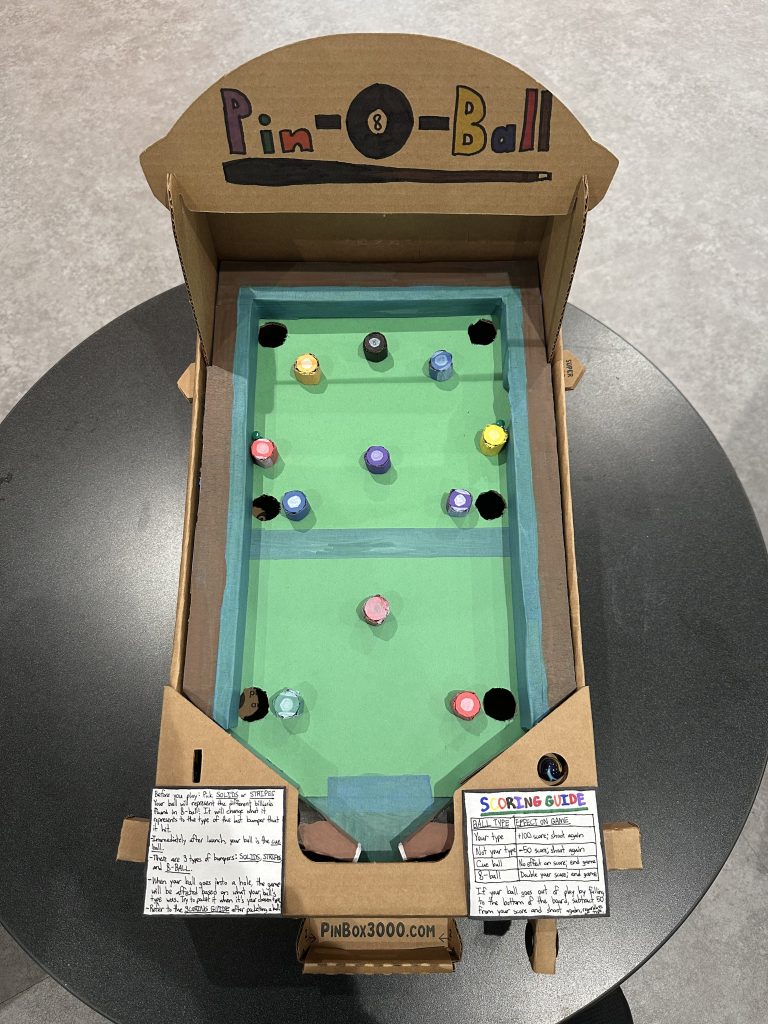
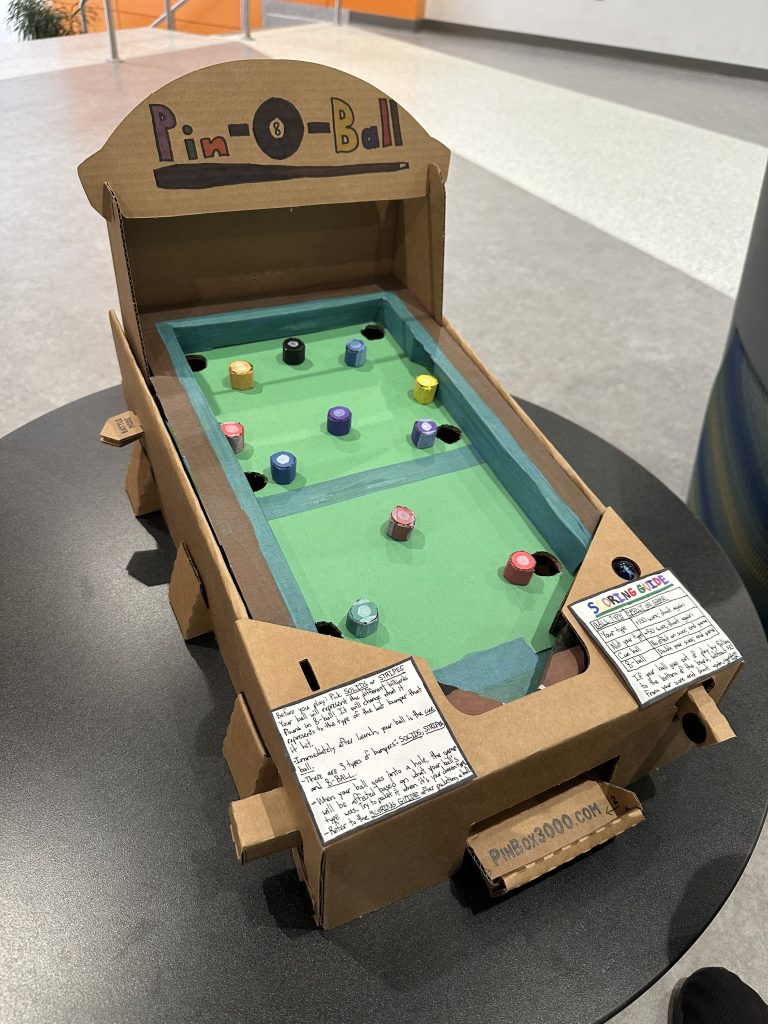

Moving Forward With Visual Pinball
Looking ahead at developing a visual version of Pin-8-Ball, I don’t think that I’ll have to make many changes to the game in general. I think that the theme and rules can be executed even better in a digital environment, so I want to proceed with making a virtual version of Pin-8-Ball by sticking with most of what’s included in the physical version. Because of this, I only plan to change a few things.
One change that I am going to make regards tracking the most previous bumper hit. One of the biggest concerns that playtesters had with Pin-8-Ball was how difficult it was to keep track of what the last bumper that they hit was. In Visual Pinball, I plan to include a backboard in the game which will automatically track and display this for players.
I also might have to change the position of the bumpers on the playfield while translating Pin-8-Ball to a digital environment. The bumpers that exist in the physical version of Pin-8-Ball aren’t super bouncy because they are made out of cardboard, so I imagine that having bouncy bumpers in the digital version can potentially change up how the game plays and feels. Because of this, I plan to do a lot of testing with both bumper positions and how bouncy they are while building the virtual game.
Final Thoughts
After executing a second playtest, I learned that a lot of players enjoyed the changes that I made, particularly the visual overhaul. There were a few lasting issues, and some new, such as continued difficulty understanding the rules, new spots where the ball can get stuck, and it being a bit difficult to actually pocket the ball while it is the cue ball or 8 ball to end the game, but I feel as though the final version is a major improvement in comparison to the prototype.
This was a fun project to work on, and I had a great time building it. Just like with my bagatelle game, Skitelle, I am happy to say that I’m proud of my creation!
